Research News
- The future directions of WBAN technology August 2, 2022
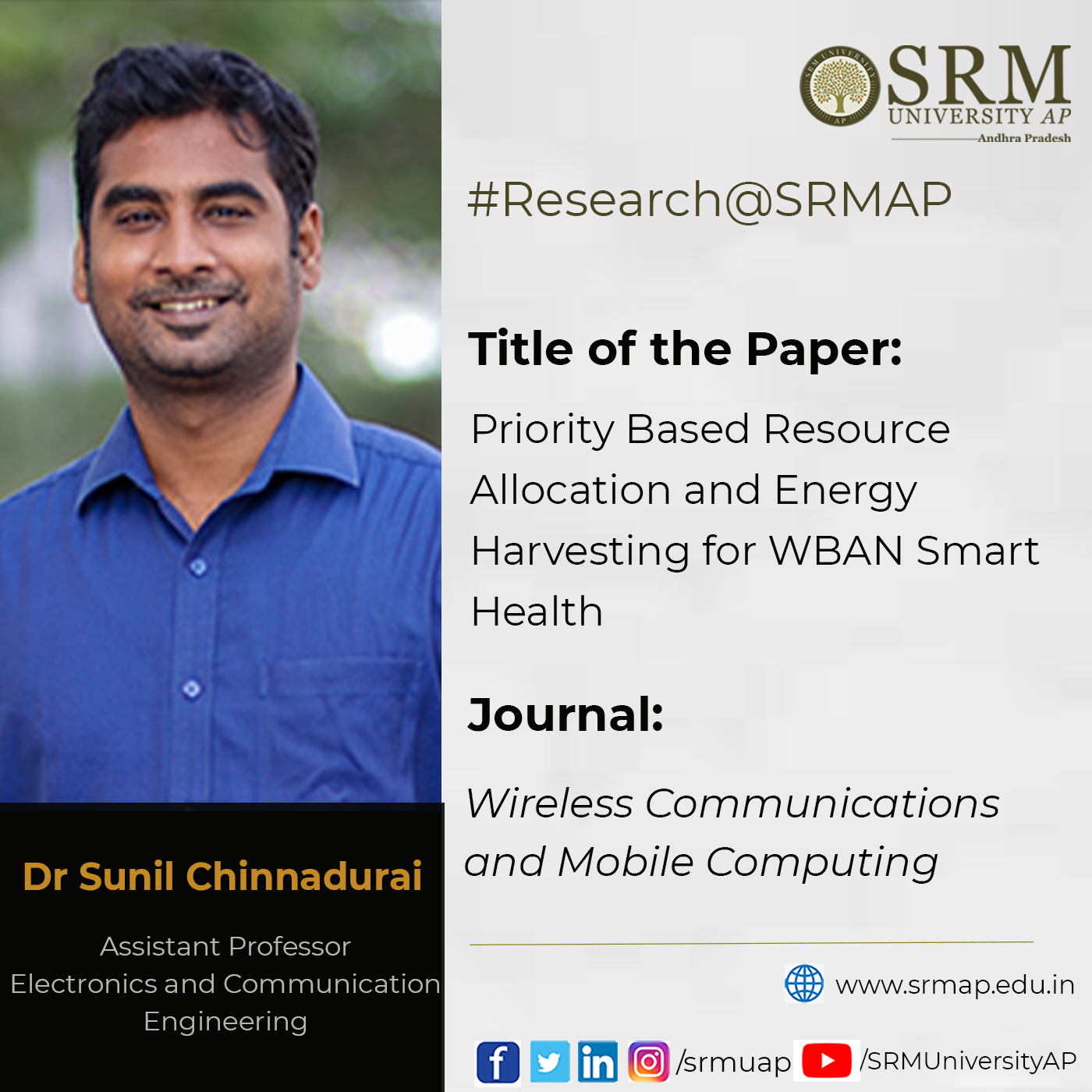 Integrated short-range wireless technologies are becoming the most sought-after machinery in recent years. The possibilities of its applications are expanding with the emergence of new health conditions and concerns. Assistant Professor of the Department of Electronics and Communication Engineering, Dr Sunil Chinnadurai’s recent research focuses on the future of this technology. His paper titled Priority Based Resource Allocation and Energy Harvesting for WBAN Smart Health got published in the journal Wireless Communications and Mobile Computing with Impact Factor 2.34. He worked with Dr Poongundran Selvaprabhu, Assistant Professor, Vellore Institute of Technology, for this project.
Integrated short-range wireless technologies are becoming the most sought-after machinery in recent years. The possibilities of its applications are expanding with the emergence of new health conditions and concerns. Assistant Professor of the Department of Electronics and Communication Engineering, Dr Sunil Chinnadurai’s recent research focuses on the future of this technology. His paper titled Priority Based Resource Allocation and Energy Harvesting for WBAN Smart Health got published in the journal Wireless Communications and Mobile Computing with Impact Factor 2.34. He worked with Dr Poongundran Selvaprabhu, Assistant Professor, Vellore Institute of Technology, for this project.Abstract
With the emergence of new viral infections and the rapid spread of chronic diseases in recent years, the demand for integrated short-range wireless technologies is becoming a major bottleneck. Implementation of advanced medical telemonitoring and telecare systems for on-body sensors needs frequent recharging or battery replacement. This paper discusses a priority-based resource allocation scheme and smart channel assignment in a wireless body area network capable of energy harvesting. The project investigates the researcher’s transmission scheme in regular communication, where the access point transmits energy and command while the sensor simultaneously sends the information to the access point. A priority schedule non-pre-emptive algorithm to keep the process running for all the users to achieve the maximum reliability of access by the decision-maker or hub during critical situations for users has been proposed. During an emergency or critical situation, the process does not stop until the decisionmaker, or the hub takes a final decision. The objective of the proposed scheme is to get all the user processes executed with minimum average waiting time and no starvation. By allocating a higher priority to emergencies and on data traffic signals such as critical and high-level signals, the proposed transmission scheme avoids inconsistent collisions. The results demonstrate that the proposed scheme significantly improves the quality of the network service in terms of data transmission for higher priority users.
Explanation of the research
A priority scheduling non-pre-emptive algorithm with SCA for WBAN smart health is proposed. The potential advantage of this algorithm is to keep on running the process for all users to attain maximum reliability until all the processes are executed. The data traffic associated with the priority scheduling non-pre-emptive algorithm is categorised into four major sub classes, namely, emergency, on-demand, normal, and non-medical data signals in order to assist the different QoS requirements. The results indicate that the priority scheduling non-pre-emptive algorithm performs during emergency and on-demand signals compared to the novel priority-based channel access algorithm for contention-based MAC (NPCA-MAC), low-rate wireless personal area networks (LR- WPAN), and priority-based adaptive schemes.
WBAN is a precise technology requiring frequent recharging or battery replacement. During the emergency or critical rescue situation, the highest priority user information is processed with minimum service delay without compromising the QoS. In addition, the proposed method prioritises the sensor nodes and classifies data traffic into emergency- (highest priority-), on-demand- (minimum priority-), normal (lowest priority-), and nonmedical- (normal-) based applications.
The future directions of WBAN are dealing with smart WBAN healthcare, trust management, trust negotiation, data security, uninterrupted lifetime, and intelligent decision-making (enhance the predictions from prior information) processes.
Continue reading → - Biowaste valorisation for environmental remediation August 1, 2022
Rampant exploitation of resources has indisputably contributed to an enormous rise in solid waste generation. It has been estimated that solid waste generation will shoot up from 1.3 billion tons to 2.2 billion tons in 2025. While 16% of the high-income countries’ population corresponds to 34% of waste being generated, only 5% of the waste generated is attributed to the low-income countries. However, it is a meagre volume of 39% that is collected leaving the rest to rot. This open dumping affects the environment and creates pollution. In addition, improper waste disposal techniques have resulted in emissions of 1.6 billion tons of CO2eq in 2016. Effective waste management is thus a matter of concern in third-world countries.
Assistant Professor Dr Karthik Rajendran and his post-doctoral scholar Dr V S Vigneswaran from the Department of Environmental Science in collaboration with Dr Mukesh Kumar Awasthi from the College of Natural Resources and Environment, Northwest A&F University, PR China, have published their research papers on solid waste management in the journal Bioresource Technology having an Impact Factor of 11.8. This is the second-best journal in the Environmental Engineering category according to SCImago Journal Rank (SJR). The journal aims to disseminate knowledge in the areas of biomass, biological waste treatment, bioresource systems analysis, and technologies associated with conversion or production.

The paper titled “Recovery of value-added products from biowaste: A review” introduces microbial biotechnology for the valorisation of solid wastes. Microbial biotechnology offers several solutions for the utilisation of waste resources. The carbon present in solid and gaseous wastes can be utilised by the microbes as carbon feedstock for their growth. During the growth of microbes on wastes, it produces primary and secondary metabolites, which are of significant use to humankind. The microbes can also be engineered biotechnologically to use waste resources and produce new compounds. Microbial biotechnology, with the use of various genetic engineering tools, can be efficiently explored for the microbes’ modification to utilise different wastes thereby making the environment clean by reducing GHG emissions.
Abstract of the Research
This review provides an update on the state-of-the art technologies for the valorization of solid wastes and its mechanism to generate various bio-products. The organic content of these wastes can be easily utilized by the microbes and produce value-added compounds. Microbial fermentation techniques can be utilized for developing waste biorefinery processes. The utilization of lignocellulosic and plastic wastes for the generation of carbon sources for microbial utilization after pre-processing steps will make the process a multi-product biorefinery. The C1 and C2 gases generated from different industries could also be utilized by various microbes, and this will help to control global warming. The review seeks to expand expertise about the potential application through several perspectives, factors influencing remediation, issues, and prospects.

Food waste in solid forms has been generated throughout the entire food life cycle, from the agricultural production process to the distribution of processed foods and even to their consumption in the market. Considering that approximately 1.3 billion tons of edible food waste is leftover annually, recycling it in the biorefinery will contribute both economically and socially. Another of their publication “Myco-biorefinery approaches for food waste valorization: Present status and future prospects” discusses various types of food waste sources and their evaluation targets. Food waste can be evaluated in fungi-based bioproduction processes for this purpose. In addition, potential biorefinery systems, circular bioeconomy processes, techno-economic studies, and social/ethical aspects of food wastes in the evaluation of valuable products are discussed.
Abstract of the Research
The increase in population and urbanization leads to the generation of a large amount of food waste (FW) and its effective waste management is a major concern. Its putrescible nature and high moisture content are the major limiting factors for cost-effective FW valorization. Bioconversion of FW for the production of value-added products is an eco-friendly and economically viable strategy for addressing these issues. Targeting the production of multiple products will solve these issues to a greater extent. The article provides an overview of the bioconversion of FW to different value-added products.
Continue reading → - Two paper presentations at international research conferences August 1, 2022
Presenting papers at international research conferences helps hone the research questions. Students from the Department of Computer Science and Engineering have attended two international research conferences and presented their papers drafted under the supervision of Assistant Professor V M Manikandan.
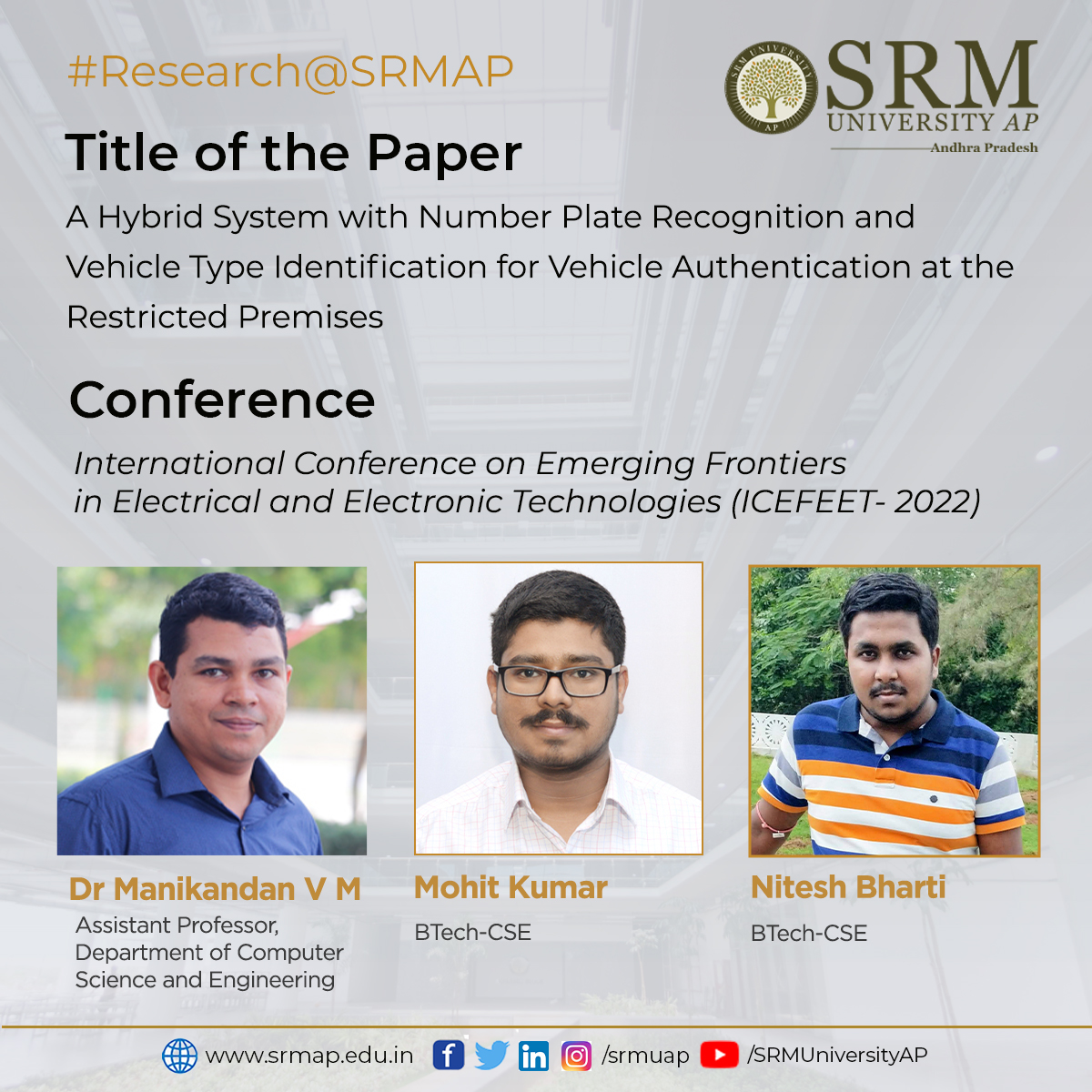 The International Conference on Emerging Frontiers in Electrical and Electronic Technologies (ICEFEET- 2022), organised by NIT Patna, India, was held from June 24 to 25. At the conference, BTech students Nitesh Bharti and Mohit Kumar presented the paper A Hybrid System with Number Plate Recognition and Vehicle Type Identification for Vehicle Authentication at the Restricted Premises. The work was composed under the guidance of Assistant Professor Dr V M Manikandan. The paper will soon be published in IEEE Xplore Digital Library (Scopus indexed). In the future, they plan to integrate the proposed algorithms with proper hardware units to completely automate the authentication of vehicles in restricted areas. The proposed computer vision-based systems can be used in restricted areas to ensure the entry of authenticated vehicles.
The International Conference on Emerging Frontiers in Electrical and Electronic Technologies (ICEFEET- 2022), organised by NIT Patna, India, was held from June 24 to 25. At the conference, BTech students Nitesh Bharti and Mohit Kumar presented the paper A Hybrid System with Number Plate Recognition and Vehicle Type Identification for Vehicle Authentication at the Restricted Premises. The work was composed under the guidance of Assistant Professor Dr V M Manikandan. The paper will soon be published in IEEE Xplore Digital Library (Scopus indexed). In the future, they plan to integrate the proposed algorithms with proper hardware units to completely automate the authentication of vehicles in restricted areas. The proposed computer vision-based systems can be used in restricted areas to ensure the entry of authenticated vehicles.Explanation of the research
Vehicle detection and number plate recognition approaches have been widely studied in recent years due to their wide applications. The research paper proposes a framework to ensure the entry of authorised vehicles in restricted areas such as University campuses, townships, etc., where the researchers are expecting the entry of a set of authorized vehicles. Certainly, unauthorised vehicles might be allowed to enter those areas after proper verification by the concerned people responsible for ensuring security. In the proposed approach, the admin should register all the authorised vehicles in a system with the essential attributes such as vehicle number, type, etc. A surveillance camera placed at the entrance will capture live videos. When a vehicle is in the camera view, the image frames will be passed to an automatic number plate recognition module. The number plate recognition module will identify the same and be matched with the details in the database to authorise the vehicle. This manuscript proposes a real-time and reliable approach for detecting and recognising license plates based on morphology and template matching. To ensure the system’s reliability, a frame selection module will select the image frames with high quality, and even to improve the number plate recognition accuracy, the image will be enhanced using image enhancement techniques such as histogram equalisation. The image enhancement techniques will help to provide better results even though the videos are taken in low lighting conditions. Further, we ensure that the vehicle type matches the number present in the database to prevent unauthorised access using fake number plates. The experimental study is conducted using videos taken under various environmental conditions such as lighting, slope, distance, and angle.
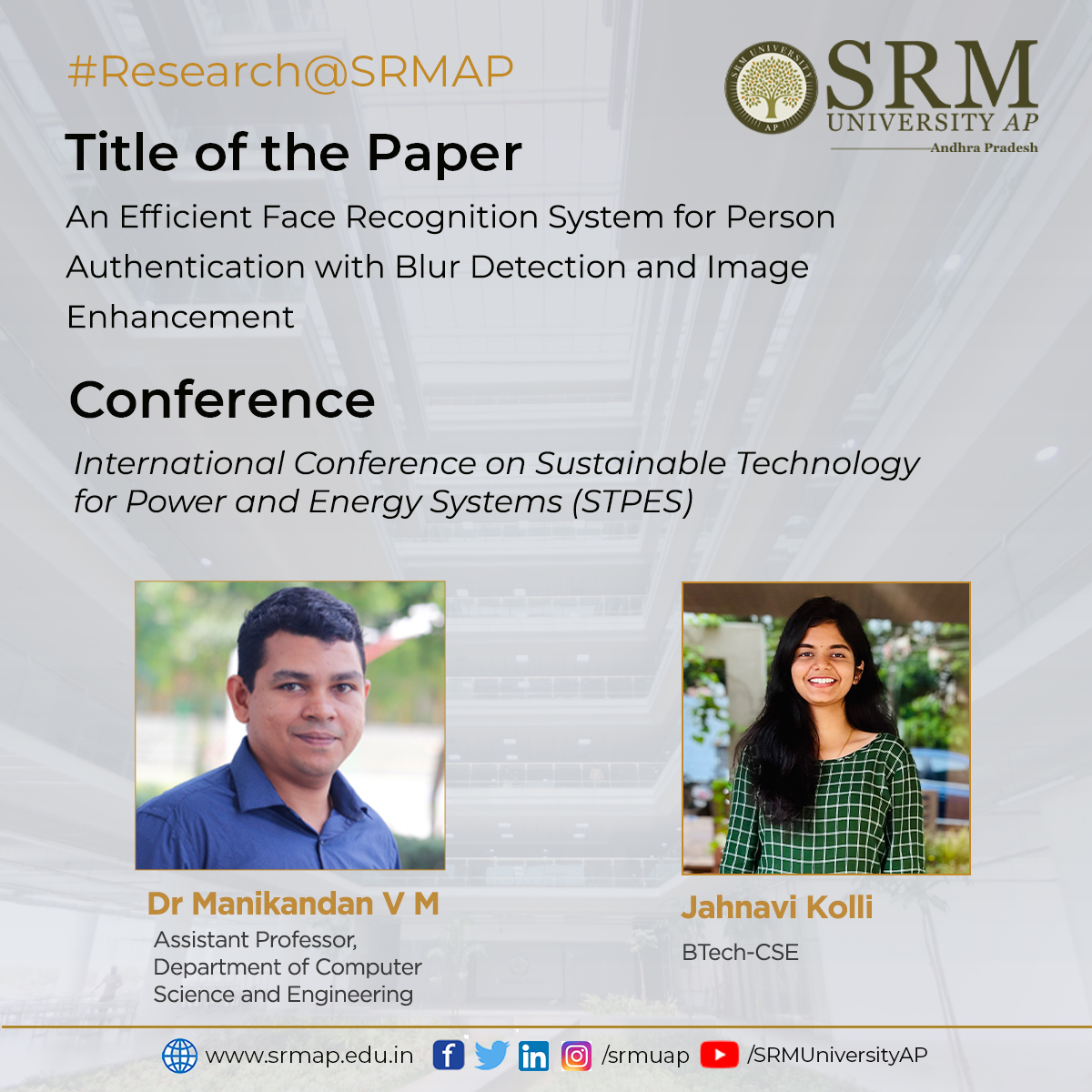 Jahnavi Kolli presented her research paper, An Efficient Face Recognition System for Person Authentication with Blur Detection and Image Enhancement, at the International Conference on Sustainable Technology for Power and Energy Systems (STPES). The conference was organised by NIT Srinagar and IIT Jammu, India, and was held from July 4 to 8, 2022. The research work was monitored by Assistant Professor V M Manikandan and done in collaboration with Professor Yu-Chen Hu, Providence University, Taiwan. The proposed computer face recognition systems can be used to record the attendance of students in class or employees in the office in an easy way. In the future, the researchers plan to improve the face recognition systems, which will perform better when the images are captured using low-resolution cameras or the face regions occluded for some reasons.
Jahnavi Kolli presented her research paper, An Efficient Face Recognition System for Person Authentication with Blur Detection and Image Enhancement, at the International Conference on Sustainable Technology for Power and Energy Systems (STPES). The conference was organised by NIT Srinagar and IIT Jammu, India, and was held from July 4 to 8, 2022. The research work was monitored by Assistant Professor V M Manikandan and done in collaboration with Professor Yu-Chen Hu, Providence University, Taiwan. The proposed computer face recognition systems can be used to record the attendance of students in class or employees in the office in an easy way. In the future, the researchers plan to improve the face recognition systems, which will perform better when the images are captured using low-resolution cameras or the face regions occluded for some reasons.Explanation of the research
The recent advancements in technology widely help to substitute manpower with machines in a better way. Even though machines are increasingly replacing humans in various ways, there are still a few areas where the use of machines still needs to be explored much more efficiently. Facial recognition systems are one such field. Facial recognition systems are used with various motives, such as identification of suspects in public places, authentication of users on restricted premises, etc. In this work, we propose a facial recognition system to facilitate the authentication of students at the university entrance. The same scheme can also be utilised to authenticate the students before entering examination halls. As the strength of the students at universities increases in a more significant way, it becomes strenuous for the security people to record their attendance manually, which frequently results in erroneous data. This paper proposes a facial recognition system that will help to capture the live videos from an area of interest and identify the faces. Further, a face recognition scheme will detect whether the person is authorised or not. Several facial recognition systems are already available in the literature, and this scheme differs from them in many ways. The proposed method selects the frames with less blur for face detection and further face recognition. A blur detection scheme is used in the proposed system to analyse the amount of blur in the image. To overcome the challenges such as low accuracy during face recognition when the images are taken in low lighting conditions, we use a histogram equalization method to enhance the quality. The experimental study shows that the proposed approach works well in real-time.
Continue reading → - Published the first article under the Indo- Israel bilateral project July 29, 2022
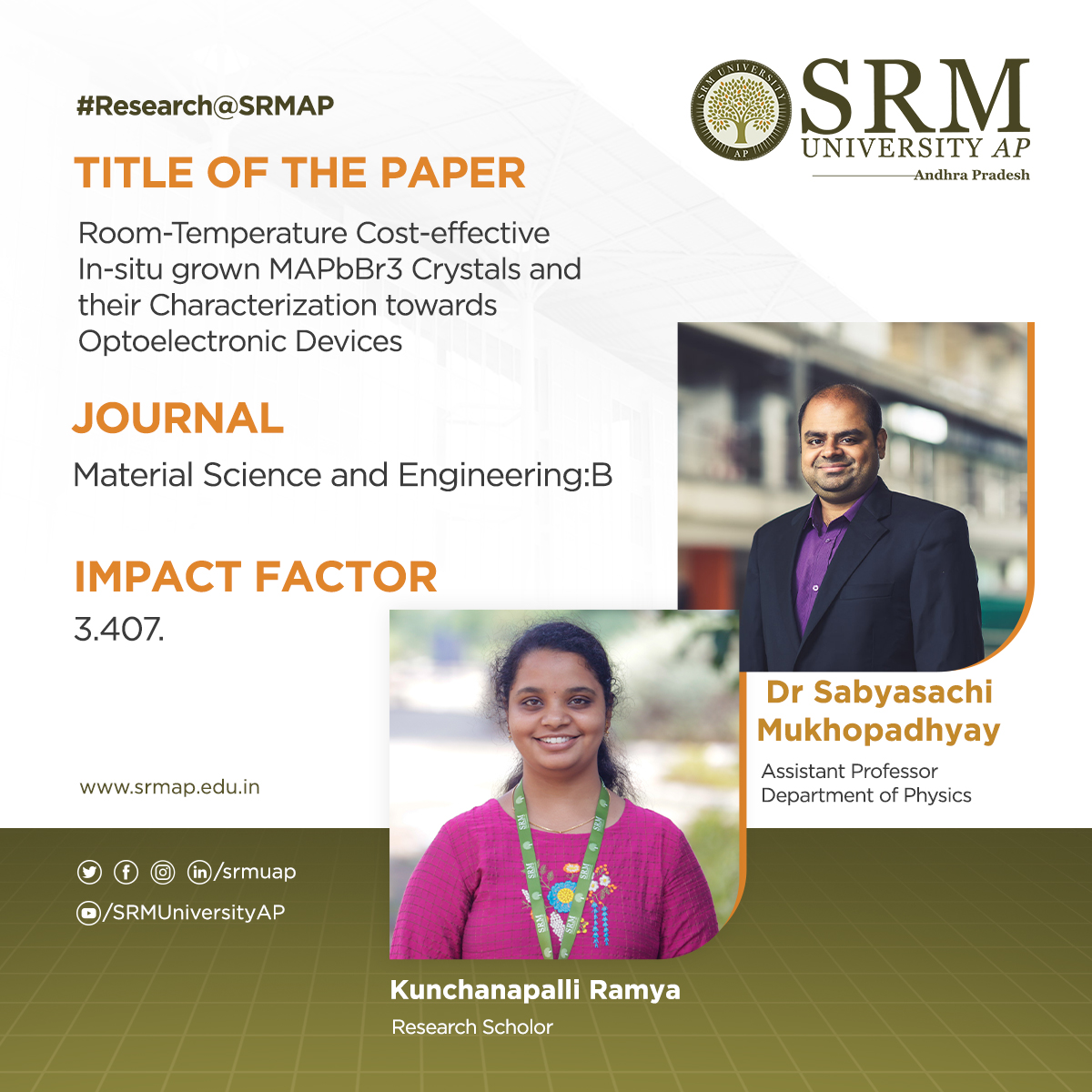 Research at the Department of Physics envisions future studies on the anisotropic properties across various planes of their reported MAPbBr3 crystals and identifying the better plane for efficient electrical contact in device applications. Assistant Professor Dr Sabyasachi Mukhopadhyay and his research scholar Kunchanapalli Ramya recently published the paper Room-Temperature Cost-effective In-situ grown MAPbBr3 Crystals and their Characterization towards Optoelectronic Devices in the journal Material Science and Engineering: B. The paper has an impact factor of 3.407. They have done this work in collaboration with Sr Satyajit, IIT- Bhilai. This is the first article published under the Indo- Israel bilateral project A Halide Perovskite-Based Photoanode for Oxygen Evolution Reaction Using a Molecular Diode in a Hybrid Nanometer Scale.
Research at the Department of Physics envisions future studies on the anisotropic properties across various planes of their reported MAPbBr3 crystals and identifying the better plane for efficient electrical contact in device applications. Assistant Professor Dr Sabyasachi Mukhopadhyay and his research scholar Kunchanapalli Ramya recently published the paper Room-Temperature Cost-effective In-situ grown MAPbBr3 Crystals and their Characterization towards Optoelectronic Devices in the journal Material Science and Engineering: B. The paper has an impact factor of 3.407. They have done this work in collaboration with Sr Satyajit, IIT- Bhilai. This is the first article published under the Indo- Israel bilateral project A Halide Perovskite-Based Photoanode for Oxygen Evolution Reaction Using a Molecular Diode in a Hybrid Nanometer Scale.Abstract
The paper reports the in-situ, room-temperature synthesis of methylammonium lead bromide CH3NH3PbBr3 crystals using N-methyl formamide as a source of methylammonium (MA+) ions during the crystallization process to explore the structural, dielectric, and electronic properties of CH3NH3PbBr3 crystals for optoelectronic applications. Optical absorption and radio-luminescence measurements affirm the direct bandgap nature of the crystals. Impedance spectroscopy measurements with various applied AC voltages within the 20 Hz – 10 MHz frequency range depict the influence of ionic motions on electrical transport across crystal planes. Researchers have extracted electrical transport parameters in CH3NH3PbBr3 crystals from the Nyquist plots, which we found to be distinctly varied wherein two different AC voltage amplitude regimes, broadly for 10 – 50 mV and 100 – 500 mV AC voltage range.
Explanation of the research
The wide approachability of our synthesis method lies in avoiding expensive precursor salts and eliminating the use of toxic solvents. We have obtained the MAPbBr3 crystals with improved thermal, optical, and dielectric properties that are used in optoelectronic devices, mainly in the applications of solar cells and photodetectors.
Continue reading → - Aesthetic labour, Body, and Femininity July 28, 2022
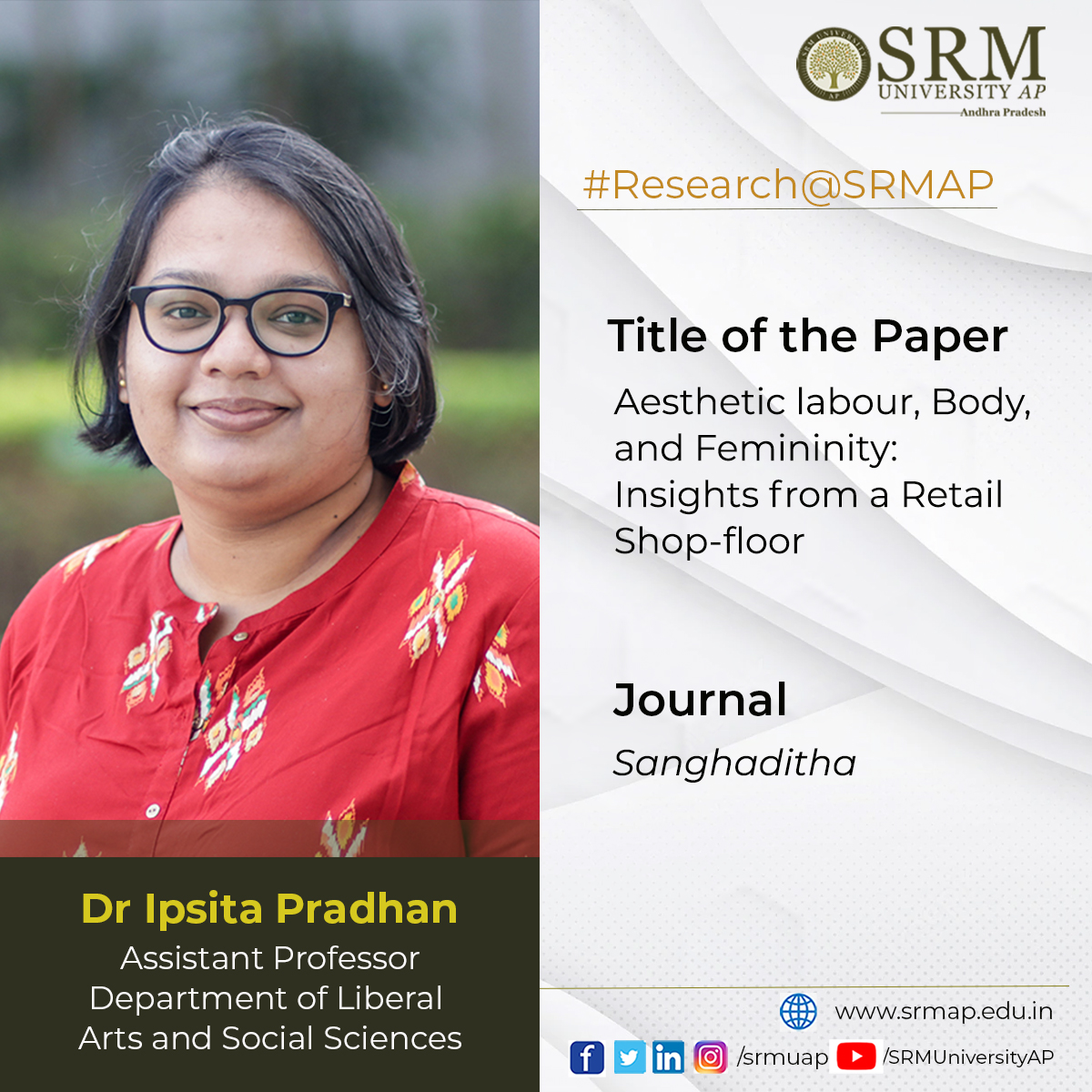 The value of certain looks or appearances is constructed intentionally, and it directly takes part in social stratification. The explanation for this practice can be found in the concept of aesthetic labour. Aesthetic labour implies the practice of screening, managing, and controlling workers on the basis of their physical appearance. When read together with femininity and body, the concept discloses several crucial dimensions. Assistant Professor Dr Ipsita Pradhan, Department of Liberal Arts, published an article titled Aesthetic labour, Body, and Femininity: Insights from a Retail Shop-floor in the journal Sanghaditha. The paper is translated from English to Malayalam by Dr Anu Kuriakose.
The value of certain looks or appearances is constructed intentionally, and it directly takes part in social stratification. The explanation for this practice can be found in the concept of aesthetic labour. Aesthetic labour implies the practice of screening, managing, and controlling workers on the basis of their physical appearance. When read together with femininity and body, the concept discloses several crucial dimensions. Assistant Professor Dr Ipsita Pradhan, Department of Liberal Arts, published an article titled Aesthetic labour, Body, and Femininity: Insights from a Retail Shop-floor in the journal Sanghaditha. The paper is translated from English to Malayalam by Dr Anu Kuriakose.Abstract
The essay discusses the importance of the body in interactive service work. By focusing on women retail shop floor workers, employed in the apparel and cosmetic sections of multi-national brands argues that employment in this sector requires working on one’s body to produce a “presentable” body by grooming so as to fit the larger image that the mall presents. The presence of the mannequin and its dressing is also analysed to understand how it perpetuates stereotypes of the ‘ideal’ body through the apparent function of attracting customers or giving the customers an idea of the products on display, simultaneously perpetuating the male gaze on ‘acceptable’ feminine bodies.
Continue reading → - Watermarking medical images for their secure transmission July 28, 2022

The Department of Computer Science and Engineering is proud to announce that Dr Priyanka, Assistant Professor, and her research Scholar, Ms Kilari Jyothsna Devi have published their patent (application no: 202241033779 A), “A System and a Method for Watermarking Medical Images for the Secure Transmission of Images”. The patent was published on June 17, 2022, by the Indian Patent Office.
In the present technology, medical images and patient information are widely transmitted through a public transmission channel in e-healthcare applications. While sharing medical images or electronic patient records (EPR) through a public network, they can get tampered with or manipulated, leading to wrong diagnosis by the medical consultants. Similarly, one can easily claim false ownership of the medical images. This makes the confidentiality of the patient record at low cost a major concern.
The proposed novel MIW scheme ensures most of the watermarking characteristics such as high imperceptibility, robustness, security with low computational cost, temper detection and recovery in medical image transmission in real-time healthcare applications. In the future, they intend to design digital image watermarking schemes for the secure transmission of images over blockchain and cloud-based applications.
Continue reading → - The genealogy of post-truth and fake news in the Indian context July 28, 2022
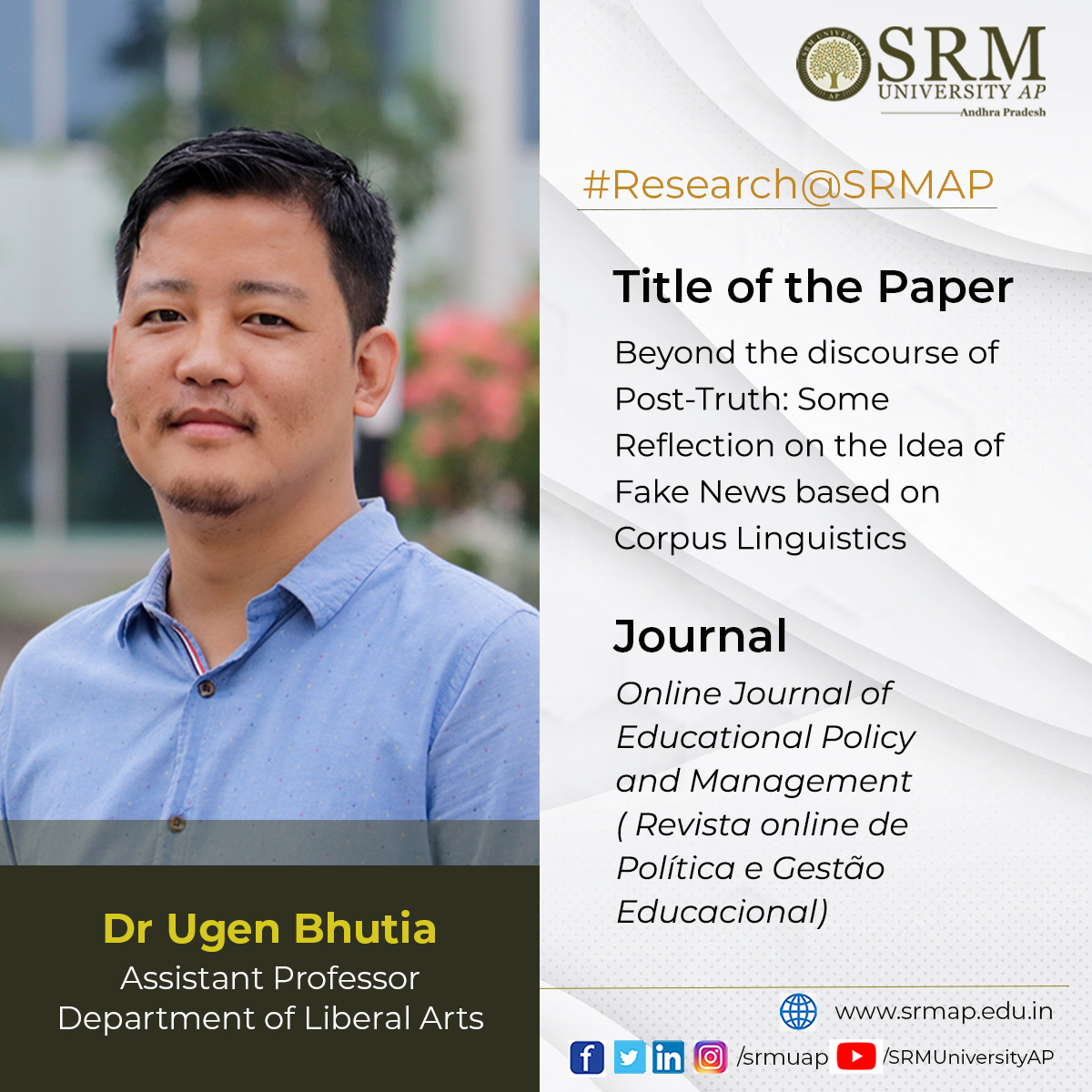 Post-truth represents the replacement of facts with personal beliefs and emotional appeals in order to shape public opinion. The distinction between fake and real news is not about reliable and unreliable sources. It’s about honesty and deception. The media can both inform and deceive people. What makes the news fake is the intention of its author. Discourses are produced by the effects of power within a social order. This power prescribes certain rules and categories that define the criteria for legitimating knowledge and truth within the discursive order. Assistant Professor Dr Ugen Bhutia of the Department of Liberal Arts published an article titled Beyond the discourse of Post-Truth: Some Reflection on the Idea of Fake News based on Corpus Linguistics in the Online Journal of Educational Policy and Management.
Post-truth represents the replacement of facts with personal beliefs and emotional appeals in order to shape public opinion. The distinction between fake and real news is not about reliable and unreliable sources. It’s about honesty and deception. The media can both inform and deceive people. What makes the news fake is the intention of its author. Discourses are produced by the effects of power within a social order. This power prescribes certain rules and categories that define the criteria for legitimating knowledge and truth within the discursive order. Assistant Professor Dr Ugen Bhutia of the Department of Liberal Arts published an article titled Beyond the discourse of Post-Truth: Some Reflection on the Idea of Fake News based on Corpus Linguistics in the Online Journal of Educational Policy and Management.Abstract
The article illustrates how we deceive ourselves by attempting to understand fake news through the notion of a post-truth society. The paper argues that the concepts of fake news and post-truth are not an aberration in the history of media practices and neither of contemporary origins. They are an intricate part of the discursive practices in which media as an institution engages. The article builds on Foucault’s approach to discursive practices and applies a meta-discursive framework to trace the genealogy of post-truth and fake news in an Indian context. The article also critically reflects on some key strategies to contain and counter fake news. For instance, media literacy and linguistic approaches such as corpus linguistics to detect fake news.
Continue reading → - Gendered work and contemporary India July 28, 2022
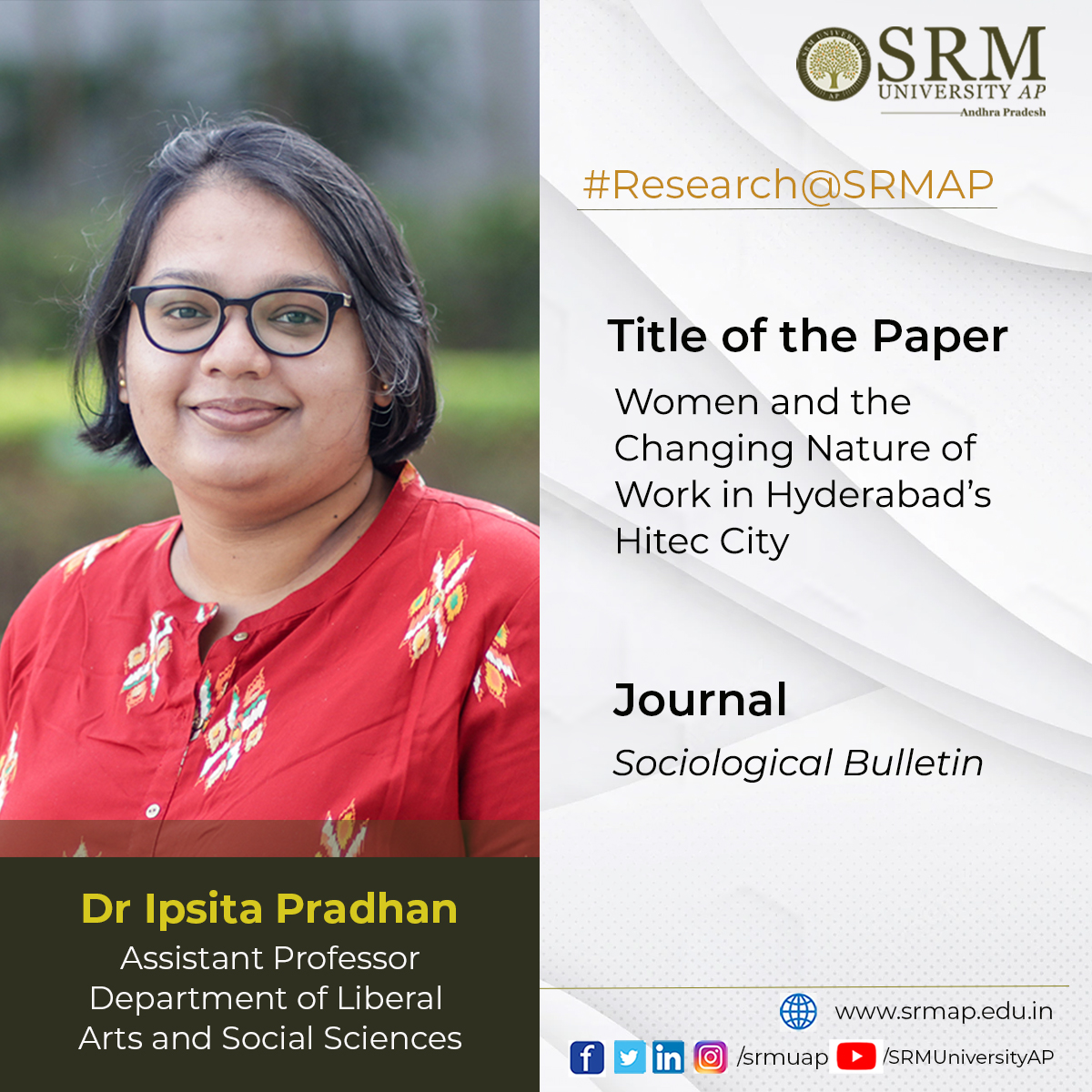 Economic institutions, technological developments, cultural norms, religious and intellectual currents, and popular beliefs have always played a huge role in asserting clear boundaries between men’s and women’s work. The recent research paper of Assistant Professor Dr Ipsita Pradhan, Department of Liberal Arts, focuses on the transformation of gendered work in contemporary India. The paper is titled Women and the Changing Nature of Work in Hyderabad’s Hitec City and was published in the journal Sociological Bulletin.
Economic institutions, technological developments, cultural norms, religious and intellectual currents, and popular beliefs have always played a huge role in asserting clear boundaries between men’s and women’s work. The recent research paper of Assistant Professor Dr Ipsita Pradhan, Department of Liberal Arts, focuses on the transformation of gendered work in contemporary India. The paper is titled Women and the Changing Nature of Work in Hyderabad’s Hitec City and was published in the journal Sociological Bulletin.Abstract
This article looks at the ways in which gendered work is being transformed in contemporary India by focussing on Hyderabad, the capital of Telangana. Since the mid-1990s, after India opened its doors to multinational agencies, new forms of gendered labour have manifested. One of the ramifications of this gendered process is the feminisation of labour that enabled the participation of more women in the workforce, engaging in activities that were low-paid. The basis of feminisation is that certain jobs require fewer skills or particular kinds of skills, for which women are thought to be suitable. This also has implications for the low bargaining power of women workers. The feminisation of the labour force in HITEC city, Hyderabad is a consequence of the changing labour markets with globalisation, offshore factories, migration, and other changes in the workplace.
Continue reading → - Dual-Band 2×2 Elements MIMO Antenna-Diplexer July 27, 2022
Dr Divya Chaturvedi, Assistant Professor, from the Department of Electronics and Communication Engineering has been keenly pursuing research on wearable antennas that are used within the context of Wireless Body Area Networks. These antennas are commonly used in wearable wireless communication and bio-medical RF systems. Her latest publication “Design and Investigation of Dual-Band 2×2 Elements MIMO Antenna-Diplexer Based on Half-mode SIW” was featured in the Q1 journal, IEEE Access, having an Impact Factor of 3.37. The research was done in collaboration with Assistant Professor Dr Goutam Rana and Research Scholar Ms Buela Pramodini from the Department of Electronics and Communication Engineering.
This antenna is designed to enhance data rate twice as much as a single antenna. The antenna can be used to operate in two frequency bands simultaneously, without causing any interference. One frequency band can be used for the transmission of data while the other frequency band can be utilised for the reception of data. The radiating elements are configured in such a way that it occupies a compact size. Thus, the designed antenna can be easily mounted or integrated into a portable wireless electronic device. The field from one radiating element is not coupled to the other element due to their adequate isolation that mitigates the interference problem.
The dual-band self-diplexing 4-port MIMO antenna operates in the lower frequency band around 3.4 GHz (3.35-3.55 GHz, 160 MHz) for the TD-LTE system and in the higher frequency band around 4.2 GHz (4.14-4.34 GHz, 200 MHz) for FCC ID WLAN in 5G LTE communication. The electronic devices which operate in these frequency bands can enhance the data transmission and reception speed twice as much as a single element. In other words, the proposed design prototype also improves the reliability of communication by employing the spatial multiplexing technique. In future, they plan to work on the design and investigation of MIMO-based self-diplexing antenna using the polarization diversity technique.
Abstract of the Research

In this article, a compact dual-band, 2-elements antenna-diplexer is investigated and extended to a 2×2 multi-input and multi-output (MIMO) antenna. The proposed design employs half-mode Substrate Integrated Waveguide (HMSIW) technology, which reduces the antenna footprint by 50%. To enhance the bandwidth, a rectangular slot is engraved at the center of each HMSIW cavity. The slot splits the dominant mode of the HM cavity into two odd- and even-half TE110 modes in proximity, which leads to enhancement in the bandwidth by 50%. The antenna resonates around 3.4 GHz with a fractional bandwidth of 5% and around 4.3 GHz with a bandwidth of 4.7%, when corresponding ports are excited, respectively. Both the lower and upper frequency bands can be tuned individually, by simply altering the dimensions of each HMSIW cavity. This can be achieved in a common antenna, without employing filters, which satisfies the antenna-diplexer function. The isolation levels between any two radiating elements are obtained below -23 dB for the proposed MIMO antenna, and it occupies an overall size of 1.0λg × 0.8λg. The peak gain of the antenna is obtained at 5.35 dBi in the lower frequency band and at 6.75 dBi in the upper frequency band while radiation efficiency is better than 80% in both frequency bands.
- Item feature refinement for improved content-based recommendation July 26, 2022
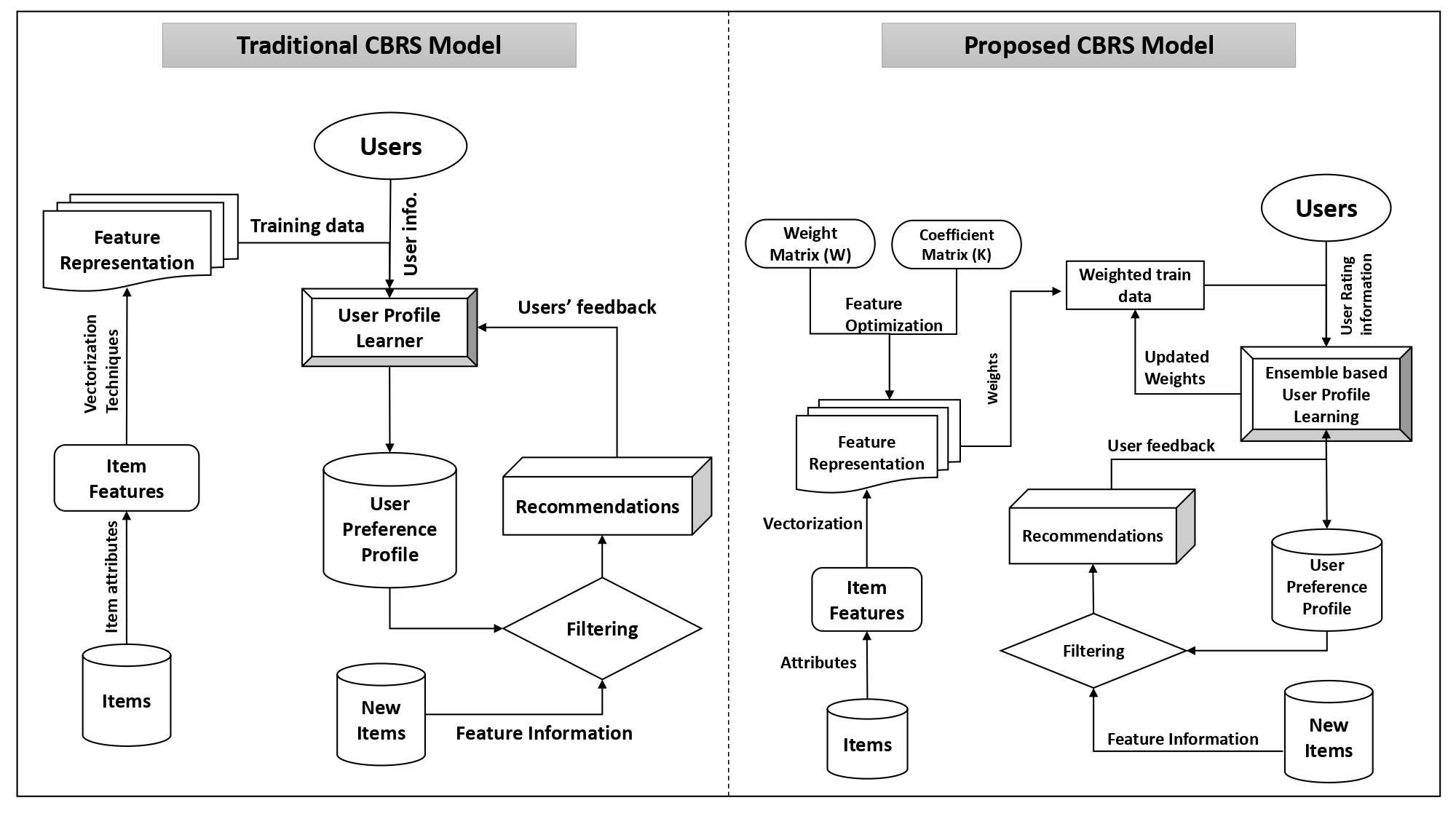
The Department of Computer Science and Engineering is delighted to announce that Dr Abinash Pujahari, Assistant Professor, has published his research article “Item Feature Refinement using Matrix Factorization and Boosted Learning based User Profile Generation for Content-Based Recommender Systems” in the journal Expert Systems with Applications having an Impact Factor of 8.665. The research was done in collaboration with Dr Dilip Singh Sisodia, Assistant Professor, National Institute of Technology Raipur.
This research focuses on improving the quality of information available about the features of various items so that it can be used for content-based recommendations. Content-based recommender systems are used in many e-commerce platforms (e.g., NetFlix, Amazon Prime, etc.). Here, the item (i.e., movies, TV shows) feature information is compared with the users’ past behaviour to recommend similar things. This research enables such systems to study the feature information for more accurate recommendations.
Most of the items’ feature information is sparse, redundant, and inconsistent. Matrix Factorization is used to avoid such inconsistencies. Further, iterative learning of user profiles is used using boosted learning approach for model building. The proposed research is compared with state-of-the-art related works using benchmark datasets and can be implemented in most e-commerce platforms and online streaming service providers. Dr Pujahari looks forwards to employing the same in group recommender systems where individuals have their preferences, in his future research endeavours.
Continue reading →

